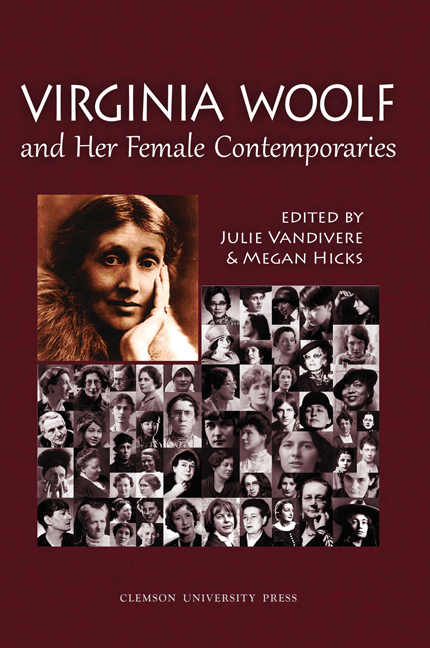Book contents
- Frontmatter
- Table of Contents
- Introduction
- Acknowledgments
- Abbreviations
- Who Are Virginia Woolf's Female Contemporaries?
- Virginia Woolf's Cultural Contexts
- Virginia Woolf's Contemporaries Abroad
- Virginia Woolf's Contemporaries at Home
- “The Squeak of a Hinge”: Hinging and Swinging in Woolf and Mansfield
- “People must marry”: Queer Temporality in Virginia Woolf and Katherine Mansfield
- The Weight of “Formal Obstructions” and Punctuation in Mrs. Dalloway and Pointed Roofs
- Advise and Reject: Virginia Woolf, the Hogarth Press, and a Forgotten Woman's Voice
- Florence Melian Stawell and Virginia Woolf: Home-front Experience, The Price of Freedom, and Patriotism
- Intimations of Cosmic Indifference in Virginia Woolf 's Orlando and Olive Moore's Spleen
- “Could I sue a dead person?”: Rebecca West and Virginia Woolf
- Splintered Sexualities in Rebecca West's The Return of the Soldier, Virginia Woolf 's Mrs Dalloway, and Sylvia Townsend Warner's “A Love Match”
- Sexual Cryptographies and War in Virginia Woolf 's Between the Acts and Elizabeth Bowen's The Heat of the Day
- Tribute to Jane Marcus
- Notes on Contributors
- Conference Program 223
Sexual Cryptographies and War in Virginia Woolf 's Between the Acts and Elizabeth Bowen's The Heat of the Day
from Virginia Woolf's Contemporaries at Home
- Frontmatter
- Table of Contents
- Introduction
- Acknowledgments
- Abbreviations
- Who Are Virginia Woolf's Female Contemporaries?
- Virginia Woolf's Cultural Contexts
- Virginia Woolf's Contemporaries Abroad
- Virginia Woolf's Contemporaries at Home
- “The Squeak of a Hinge”: Hinging and Swinging in Woolf and Mansfield
- “People must marry”: Queer Temporality in Virginia Woolf and Katherine Mansfield
- The Weight of “Formal Obstructions” and Punctuation in Mrs. Dalloway and Pointed Roofs
- Advise and Reject: Virginia Woolf, the Hogarth Press, and a Forgotten Woman's Voice
- Florence Melian Stawell and Virginia Woolf: Home-front Experience, The Price of Freedom, and Patriotism
- Intimations of Cosmic Indifference in Virginia Woolf 's Orlando and Olive Moore's Spleen
- “Could I sue a dead person?”: Rebecca West and Virginia Woolf
- Splintered Sexualities in Rebecca West's The Return of the Soldier, Virginia Woolf 's Mrs Dalloway, and Sylvia Townsend Warner's “A Love Match”
- Sexual Cryptographies and War in Virginia Woolf 's Between the Acts and Elizabeth Bowen's The Heat of the Day
- Tribute to Jane Marcus
- Notes on Contributors
- Conference Program 223
Summary
Welcomed early into British literary circles by Virginia Woolf, Anglo-Irish writer Elizabeth Bowen has been deemed the “heir to Bloomsbury” (Glendinning 75, 77). This legacy plays out nowhere more clearly perhaps than in Bowen's and Woolf 's shared use of the cryptographic in their novels bracketing World War II— Woolf 's Between the Acts (1941), a country house novel set in June 1939, in the final weeks of peace before the war (and composed during the Blitz), and Bowen's The Heat of the Day, a spy novel published in 1948, set largely in 1942 with a flashback to the Blitz and a forward glimpse into 1944. Although Bowen realizes a landscape only intimated by Woolf, both use war as a focalizing point for examining the intersection of history and private experience as embodied in the ages of their female protagonists: Woolf 's Isa Oliver, “the age of the century, thirty nine” (BTA 19) and Bowen's Stella Rodney, “younger by a year or two than the century” (Heat 24). Despite the difference between Woolf 's experimental, fragmented form and Bowen's mannered prose and surface realism, both novels employ “cryptic” sexual and political codes, with resonant silences and submerged meanings. The characters in both novels thus live within a lexical framework in which conversations never fully yield their meaning. Similarly, Bowen creates characters whose language does not correspond to predictable and known sequences. Stella Rodney, a translator, “lived at the edge of a clique of war, knowing who should know what, commanding a sort of language in which nothing need be ever exactly said” (Heat 191).
Both Woolf and Bowen critics have noted the verbal coding reflective of shifting practices of sexual or gendered expression in the authors’ works (Coy-Dibley 1, Cramer 121). In particular, lesbian scholars in the 1990s recognized Woolf 's embedding of homoerotic content within patterns of “subterfuge” consonant with gay writers of the 1920s and 30s. As Patricia Cramer notes, Woolf crafted her work to “‘pass’ within the dominant culture” and simultaneously “communicate subversive in-group messages to savvy readers” (123). Her novels thus required a “knowing eye” capable of decoding the semiotics of same-sex messaging, an eye that, as Cramer shows, Woolf herself turned on Bowen.
- Type
- Chapter
- Information
- Virginia Woolf and Her Female Contemporaries , pp. 202 - 208Publisher: Liverpool University PressPrint publication year: 2016



